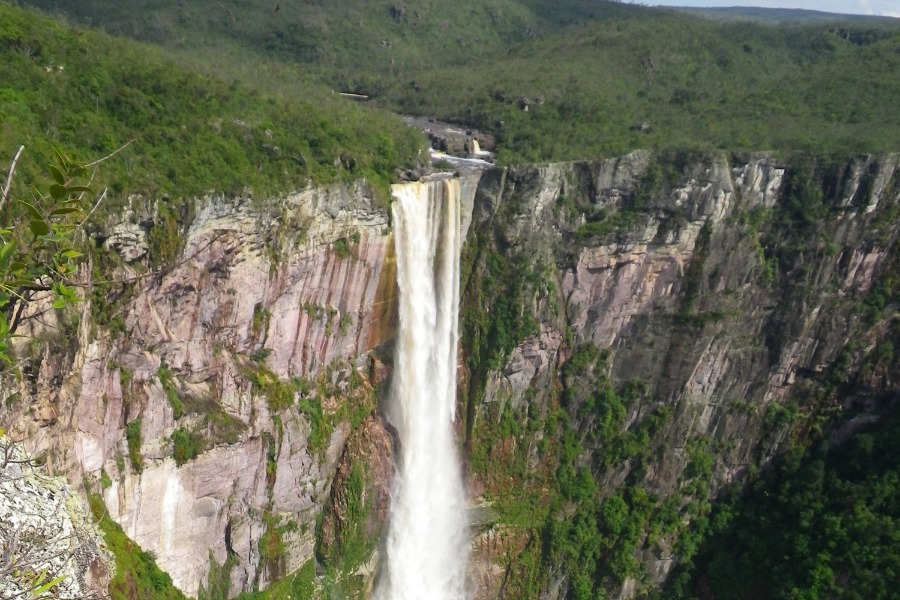
Aracá Waterfall
22-06-2021
The El Dorado waterfall, on the Aracá River, the largest waterfall in Brazil, plunges 353 meters high into the middle of the Amazon mountains. It is located in the Serra do Aracá State Park, 211 km in a straight line from Barcelos, seat of the municipality, in the far north of the state of Amazonas (northern region of Brazil) on the border with Venezuela and the Brazilian state of Roraima. The Serra do Aracá State Park, created in 1990, occupies an area of ??1,818,700 ha (18,187 km²), i.e 15% of the area of ??the municipality of Barcelos (the second largest municipality in Brazil). The area of ??the park is equivalent to approximately 20% of the national territory of Portugal and 42% of the State of Rio de Janeiro.
Access to the site is quite difficult and is only possible part of the year, from April to September, during the rainy season, when the Rio Negro is navigable. The 534 km route from Manaus to Barcelos includes three options: The regional boat, also known as “Recreio”, takes around 32 hours of travel, passing through the Amazonian beauties of the Anavilhanas archipelago and the archipelago of Mariuá. The express boat, known as “Jato”, takes 12 hours to make the trip and everyone is seated, like in a bus. You can also travel with MAP Linhas Aéreas, which has been operating the Manaus-Barcelos section since 2015 in small planes, with a capacity of 66 and 44 passengers. To explore the park, the routes are mainly along difficult to access trails or by "flying boat", a small outboard motorboat, ubiquitous in northern Brazil, up the Cuieiras River, a tributary of the Aracá river. Another option is to hire a seaplane. To climb from the foot of the mountain to the top, there are only two options: by helicopter (45 minutes) or on foot (4 to 5 days). There are 700 kilometers by large boat from Novo Airão, 70 kilometers by speedboat and another 12 kilometers on foot. In total, adding the stops and camps, the expedition lasts 12 days. It is mandatory to be part of an expedition group, complying with the regulations of the State Secretary for the Environment (SEMA) and you should know that you are held solely responsible for the visit, as there is no tourist infrastructure on site and only a few agencies sell tours at high prices due to the complicated logistics.
The region, still little explored and mainly the target of scientific expeditions, is characterized by “tepuis”, which are mountains above 2000 meters above sea level in the form of tables, like the Serra do Aracá itself, formed by the geological residues of the famous Monte Roraima located on the border with the conservation unit of the same name, by impressive rivers, river islands and white sand beaches. The Serra do Aracá, rich in biodiversity, has the typical fauna of mountain regions and the dense rain forest (mountainous and sub-mountainous), sheltering a great animal and plant diversity, in which we find beautiful species of hummingbirds and the rooster bird (galo-da-serra), orange in color, blue mushrooms, bromeliads and some new plant species hitherto unknown to science, which have been collected in the park, together with Andean species that were recorded there. The region has a high potential for ecotourism, not only for the beauty of its landscapes, but also for its water streams, with a large number of ornamental fish species.
The gateway to all this incredibly varied and interesting region is the historic town of Barcelos, founded in 1728 and the first capital of the province of Amazonas before being replaced by Manaus, known for its river beaches on the banks of the Rio Negro. In addition to El Dorado, which can be accessed from the Guyanese plateau, other waterfalls attract the attention of tourists and researchers. With more than 200 meters in height and a breathtaking landscape, the waterfalls of Anta, Boto, Desabamento, Cuieiras and Surpresa, guarantee a lot of aquatic pleasures in their natural pools. The deepest cave in the world with 671 meters of vertical drop, dubbed the Guy Collet Abyss, is mysteriously embedded in the middle of the Amazon rainforest. From Barcelos you can also access the Jaú national park and the Mariuá environmental protection zone, considered to be the largest river archipelago in the world, with more than 1,400 islands.
Cachoeira do eldorado picture Carlos Durigan